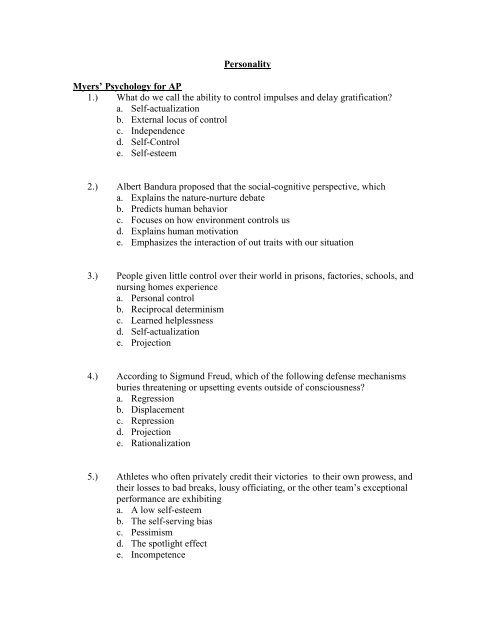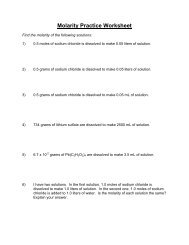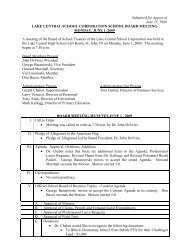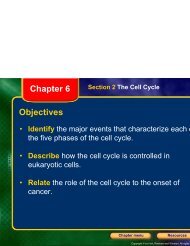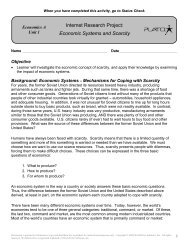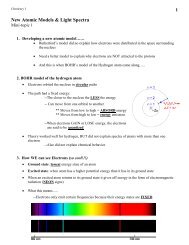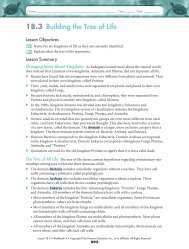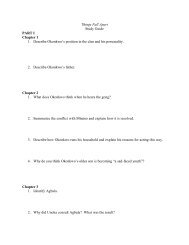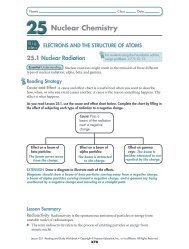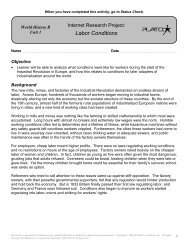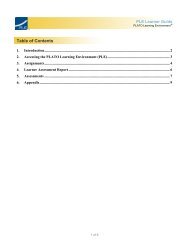Personality Test - Lake Central High School
Personality Test - Lake Central High School
Personality Test - Lake Central High School
Create successful ePaper yourself
Turn your PDF publications into a flip-book with our unique Google optimized e-Paper software.
<strong>Personality</strong>Myers’ Psychology for AP1.) What do we call the ability to control impulses and delay gratification?a. Self-actualizationb. External locus of controlc. Independenced. Self-Controle. Self-esteem2.) Albert Bandura proposed that the social-cognitive perspective, whicha. Explains the nature-nurture debateb. Predicts human behaviorc. Focuses on how environment controls usd. Explains human motivatione. Emphasizes the interaction of out traits with our situation3.) People given little control over their world in prisons, factories, schools, andnursing homes experiencea. Personal controlb. Reciprocal determinismc. Learned helplessnessd. Self-actualizatione. Projection4.) According to Sigmund Freud, which of the following defense mechanismsburies threatening or upsetting events outside of consciousness?a. Regressionb. Displacementc. Repressiond. Projectione. Rationalization5.) Athletes who often privately credit their victories to their own prowess, andtheir losses to bad breaks, lousy officiating, or the other team’s exceptionalperformance are exhibitinga. A low self-esteemb. The self-serving biasc. Pessimismd. The spotlight effecte. Incompetence
6.) What did Abraham Maslow call the process of fulfilling our potential?a. Love needsb. Self-esteemc. Self-actualizationd. Self-transcendencee. Hierarchy of needs7.) Our_____ consists of all the thoughts and feelings we have in response to thequestion “Who am I?”a. Self-conceptb. Ideal selfc. Self-esteemd. Empathye. Self-acceptance8.) Sigmund Freud called his theory of personality and the associated treatmenttechniquesa. Psychoanalysisb. The humanistic approachc. The self-conceptd. The psychosexual stagese. Free inventories9.) Questionnaires covering a wide range of feelings and behaviors designed toassess several traits at once are calleda. Factor analysis studiesb. Peer reportsc. Achievement testsd. Cognition testse. <strong>Personality</strong> inventories10.) Collectivist cultures are characterized by membersa. Developing a strong sense of selfb. Giving priority to group goalsc. Forming casual, often temporary relationshipsd. Achieving personal goalse. Discovering how they are different from the group11.) Critics of humanistic psychology have suggested that this theory fails toappreciate the reality of our human capacity fora. Empathyb. Lovec. Negativityd. Evile. Laziness
12.) Our self-focused perspective many motivate us, but it can also lead us topresume too readily that others are noticing and evaluation us. This is calleda. Self-monitoringb. Self-schemasc. Possible selvesd. The spotlight effecte. The social-cognitive perspective13.) Brad Bushman and Roy Baumeister found that when criticized, people withunrealistically high self-esteema. Became exceptionally aggressiveb. Were more receptive to the criticismc. Became easily depressedd. Worked harder to do better the next timee. Quit the task without completing it14.) According to Carl Rogers, when we are in a good marriage, a close family, orintimate friendship, we are free to be spontaneous without fearing the loss ofothers’ esteem. He called the accepting attitude that enables the freedoma. A peak experienceb. Unconditioned positive regardc. Self-transcendenced. Humanistic psychologye. Our self-concept15.) Children’s TV-viewing habits (past behavior) influence their viewingpreferences (internal personal factor), which influence how television(environmental factor) affects their current behavior. This is an example ofa. Personal controlb. Learned helplessnessc. Reciprocal determinationd. The Big Five traitse. Implicit learningFast Track to a 516.) <strong>Personality</strong> is defined asa. Infrequent and often omitted behaviorb. A unique and consistent pattern of thinking, feeling, and actingc. A universally accepted way of viewing behaviord. A perception based on past experiences and viewpointse. Something that happens by chance
17.) Which of the following discovered that not all disorders could be explainedthrough physical causes?a. Gordon Allportb. Raymond Cattellc. B.F. Skinnerd. Sigmund Freude. Carol Rogers18.) Sigmund Freud believed that a person’s thoughts, feelings, and behaviors aredetermined bya. Various unconscious influencesb. The interaction of thoughts, feelings, and behaviorsc. <strong>Central</strong> secondary traitsd. Self-actualizatione. Secondary traits19.) A baby cries in the middle of the night and demands immediate gratificationfrom his or her care giver. Freud would suggest that this child’s immediategratification is based on thea. Reality principleb. Pleasure principlec. Actualizing tendencyd. Moral principlee. Inferiority complex20.) Suzy was tempted to cheat on her exam, but quickly remembered thatcheating is wrong and immoral. Freud would say that the thought thatcheating was wrong come from thea. Egob. Idc. Superegod. Collective unconsciouse. Unconditional positive regard she received as a child21.) Will received an “F” on his exam. He quickly pointed out to fellowclassmates that the exam questions were not covered on the review and thatthe teacher had not indicated that they would be included in the exam. Will isexhibiting which type of defense mechanism?a. Compensationb. Displacementc. Sublimationd. Rationalizatione. Regression
22.) During which psychosexual stage does a boy develop strong sexual stages forhis mother?a. Anal stageb. Oral stagec. Genital staged. Phallic stagee. Latency stage23.) Stan is the youngest in a very competitive family. As a result, Stan often doesnot get attention or succeed in family activities. Stan’s classmates havenoticed that he strives to win at all classroom activities. Which neo-Freudianwould state that Stan’s competitiveness is in response to his childhoodexperience?a. Carl Jungb. Karen Horneyc. Alfred Adlerd. Erik Eriksone. Carol Rogers24.) Everyone who knows him describes Tom as a caring person. No matter whatthe situation, he is always there to offer support to those who need it.According to Gordon Allport, Tom’s display of caring would be an exampleof what trait?a. Stableb. <strong>Central</strong>c. Secondaryd. Aggressivee. Loving25.) A mathematical formula that is used to describe the relationships among traitsis calleda. Factor analysisb. Case studyc. Naturalistic observationd. Correlation studye. Survey26.) The Big-five traits are conscientiousness, extraversion, agreeableness,neuroticism, anda. Optimismb. Pessimismc. Openness to experienced. Happinesse. Self-actualization
27.) According to Albert Bandura, reciprocal determinism is the combination ofthinking, behavior, anda. Environmentb. Verbal skillsc. Stabilityd. Optimisme. Conditions28.) Carl Rogers said that the ______ is (are) an innate drive that motivates allhuman behavior toward growtha. Unconsciousb. <strong>Central</strong> traitsc. Actualizing tendencyd. Wish fulfillmente. Ego29.) Jane was asked to look at a series of ambiguous pictures and describe whatthey saw. This would be an example of which type of personality test?a. Case studyb. Naturalistic observationc. Surveysd. Projectivee. Factored30.) The MMPI is classified as a (an)a. Objective testb. Projective testc. Descriptive studyd. Interviewe. ExperimentMcGraw Hill31.) Adam loved the girlfriend who dropped him, but acts as if he’s glad to be ridof her. His behavior most clearly illustrates which of the following Freudiandefense mechanisms?a. repressionb. projectionc. reaction formationd. sublimatione. regression
32.) Which Freudian personality system is guided by the reality principle?a. idb. libidoc. egod. unconsciouse. superego33.) In contrast to the blank slate view of human nature held by the behaviorists,humanists believe humans are born?a. evil and instinctively selfishb. good and with an inner drive o reach full potentialc. neutral and that personality is based on perceptions of realityd. neither good nor evil, but personality is a product of their environmente. weak and needing others to find a meaning and purpose in life34.) Which of the following is a good example of a Jungian archetype?a. John, whose domineering mother’s voice is always in the back of his headb. Patty, who is haunted by her memories of child abusec. Yan, who always roots for the underdogd. Tariq, who consciously strives to be the best tennis player he can bee. Kendra, whose power motive influences everything she does35.) Which is an example of a projective test, consisting of a set of ambiguouspictures about which people are asked to tell a story?a. TATb. MMPI-2c. 16 PFd. NEO-PIe. Rorschach36.) In order to determine a client’s personality, Carl Rogers used a Q-sort tomeasure the difference betweena. self-esteem and self-efficacyb. ideal self and real selfc. locus of control and self-actualizationd. conditions of worth and locus of controle. ego strength and need for approval37.) Nomothetic studies cannot provide information abouta. unique personality characteristics of an individualb. common traits that characterize most peoplec. personality dimensions that differentiate normal people from people withpsychological disordersd. traits more common in older people compared with childrene. personality characteristics of a typical teenager
38.) Bertha is tall, thin, and frail. She enjoys studying and reading science fictionnovels. She prefers to be alone rather than in a large group. According toSheldon’s somatotype theory of personality, she isa. an endomorphb. an ectomorphc. a mesomorphd. an extroverte. an introvert39.) The most commonly used personality assessments area. projective testsb. naturalistic observationsc. structured interviewsd. self-report inventoriese. behavior assessments40.) Self-efficacy, according to Bandura, isa. how you view your worth as a personb. how you think your self-imagec. all you know about your deficiencies and weaknesses as a persond. what others have conditioned you to see in yourselfe. how contempt you feel to accomplish tasks and goals41.) Mother Theresa’s altruism showed in everything she did. According toAlport’s trait theory, Mother Theresa’s altruism wasa. a common trait she shared with most other religious peopleb. a cardinal traitc. one of several central traits that characterized her exceptional lifed. basically inherited from her fathere. a surface trait that was visible to others42.) Adler would not have agreed with the importance of which of the followingideas?a. birth orderb. styles of lifec. striving for superiorityd. fictional finalisme. womb envy43.) Roberto believes that he is the master of his ship and in charge of his destiny.According to Rotter’s theory of personality, Roberto hasa. an external orientation to the world about himb. an internal locus of controlc. an extraverted personalityd. a low sense of self-efficacye. a positive self-image, but is not self-actualized
44.) Collective-efficacy would probably be more beneficial than self-efficacy forachieving group goals ina. Canadab. Englandc. Puerto Ricod. South Koreae. MonacoKaplan45.) A relatively permanent characteristic of personality that can be used to predictbehavior isa. the idb. the egoc. the superegod. a defense mechanisme. a trait46.) Which of the following statements best captures Freud’s point of view aboutpersonality?a. <strong>Personality</strong> is the result of our reinforcement historyb. <strong>Personality</strong> is learned from our parents by being around themc. <strong>Personality</strong> is result of a group of clustered traitsd. <strong>Personality</strong> is the result of our shared evolutionary history with all thosethat came before use. <strong>Personality</strong> is the result of unconscious drives or conflicts that we need toresolve47.) “Our personality is nothing more than acquired habits that we learned throughour experience.” What theory would support this statement?a. Traitb. Psychodynamicc. Learningd. Cognitivee. Humanistic48.) the approach of personality championed by Carl Rogers is calleda. learningb. traitc. psychodynamicd. humanistice. Neo-Freudian
49.) Carl Rogers is often classified as a ___________ theorist.a. learningb. traitc. psychodynamicd. humanistice. Neo-Freudian50.) During the _________ stage of Freud’s theory, the focus is on controllingone’s environment.a. Oralb. Analc. Phallicd. Latencye. Genital51.) You have three friends: the first is bossy and always tells you what to do, thesecond is always telling you what is right or wrong, and the third tries to helpmediate between the two. If you were giving Freudian nicknames to yourfriends, they would be, in order,a. Id, superego, egob. Id, ego, superegoc. Ego, superego, idd. Superego, id, egoe. Superego, ego, id52.) According to Freud, your memory of your own birth would be at what level ofconsciousness?a. Unconsciousb. Subconsciousc. Consciousd. Preconsciouse. REM53.) You have to decide what you are going to do with your life. To do this, youdecide to flip a coin. Based on the results of the flip, you decide to go tocollege. Such a behavior could be explained by looking at your past behaviorsand seeing if you have been rewarded for such behavior before. Whatperspective of personality does this example illustrate?a. Psychodynamicb. Humanisticc. Learningd. Traite. Phenomenological
54.) The humanistic approach to personality makes which of the following claims?a. We are all inherently goodb. We are all inherently badc. We are born a blank slated. We are born with genes that determine who we becomee. We are born with genes that gives us potential, but our experience reallydetermines who we become55.) Phil has anxiety because he has very strong anger toward his parents. Heknows this isn’t right, so he decides to work hard to do all his chores andhomework. According to the psychodynamic approach, Phil is engaging inwhich defense mechanism?a. Projectionb. Sublimationc. Reaction formationd. Transferencee. Denial56.) The part of the collective unconscious that represents who we really are is thea. Maskb. Idealc. Animad. Animuse. Self57.) Information that is not available to conscious awareness because it would betoo damaging is in the ________ level of consciousness.a. Subconsciousb. Unconsciousc. Consciousd. Presubconsciouse. Preconscious58.) Information that is not immediately available but could be if we wanted to callit to mind is in the ________ level of consciousnessa. Subconsciousb. Unconsciousc. Consciousd. Presubconsciouse. Preconscious
65.) Who would be considered a proponent of the humanistic view of personality?a. Rogersb. Kelleyc. Wundtd. Skinnere. FreudThe Princeton Review66.) According to Freudian theory, which part of the mind operates according tothe reality principle?a. The superegob. The egoc. The idd. The archetypee. The shadow67.) The defense mechanism of reaction formation is defined asa. Directing angry feelings away from the source of the anger to a lessthreatening objectb. Reverting to behaviors more characteristic of childhoodc. Attempting to make up for failures in certain areas by overcompensatingefforts in other areasd. Creating excuses for irrational feelings of behaviors that sound logicale. Reversing the direction of a disturbing feeling or desire to make it safer ofmore socially acceptable68.) All of the following personality theorists can be considered psychodynamic inapproach EXCEPTa. Karen Horneyb. Carl Jungc. Alfred Adlerd. Albert Bandurae. Erik Erikson69.) In Rogerian theory, the process by which human beings attain their fullcreativity and potential is termeda. Self-esteemb. Self-amplificationc. Self-efficacyd. Self-actualizatione. Self-reflection
70.) A psychologist interested in demarcating and measuring traits would mostlikely use which of the following?a. The 16 PF questionnaireb. The WAISc. The DSM-IVd. The ANOVAe. The WISC
KEY1.) D 45.) E2.) E 46.) E3.) C 47.) C4.) C 48.) D5.) B 49.) D6.) C 50.) B7.) A 51.) A8.) A 52.) A9.) E 53.) C10.) B 54.) A11.) D 55.) B12.) D 56.) E13.) A 57.) B14.) B 58.) E15.) C 59.) E16.) B 60.) B17.) B 61.) A18.) A 62.) E19.) B 63.) E20.) C 64.) A21.) D 65.) B22.) D 66.) B23.) C 67.) E24.) B 68.) D25.) A 69.) D26.) C 70.) A27.) A28.) C29.) D30.) A31.) C32.) C33.) B34.) C35.) A36.) B37.) A38.) B39.) D40.) E41.) B42.) E43.) B44.) D


